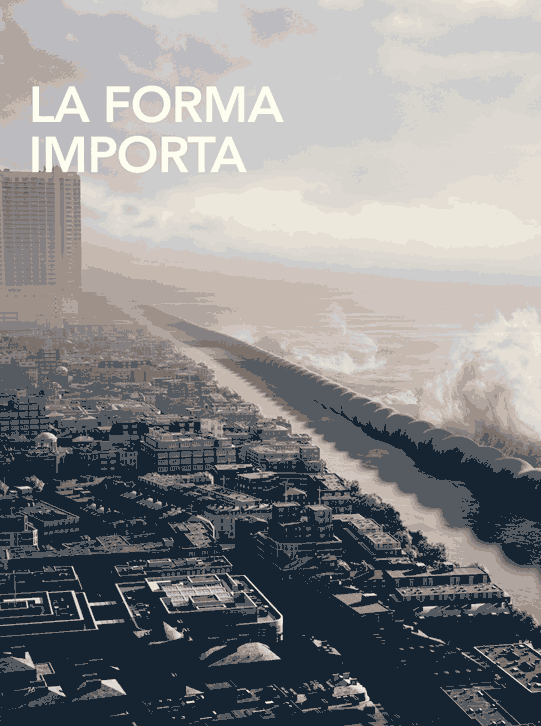La forma importa
Article Sidebar

Keywords:
Main Article Content
Abstract
A través de la historia, los maestros de la construcción han dado pasos significativos en el aprovechamiento de formas para definir espacios tridimensionales, para proporcionar refugio y protección o hacer puentes sobre vacíos, como los ocasionados por los cursos de agua y los caminos. En ausencia de métodos de predicción numérica, ellos debieron desarrollar prácticas de construcción por medio del ensayo y el error o teorías estructurales para establecer una forma estructural “suficientemente buena”. Actualmente, experimentamos un renacimiento de las formas libres como expresión arquitectónica; sin embargo, el desempeño estructural como principal impulsor del diseño es a menudo excluido del proceso inicial de diseño. La investigación del Form Finding Lab (Universidad de Princeton, EE.UU.) puede ubicarse en la tradición del modelado a base de fuerzas, indagando nuevas estrategias numéricas para generar formas estructurales únicas de vanguardia. Aquí se presentan tres estudios que muestran el desarrollo de esas técnicas, las que, cuando se emplean con procesos constructivos bien ejecutados, producen formas sorprendentes para puentes peatonales, cubiertas y barreras.
Abstract
Master builders throughout history have made significant strides in exploiting forms to enclose three-dimensional spaces, to provide shelter and protection or to bridge voids, such as water and roadways. In the absence of numerical prediction methods, they resorted to trial and error construction practices or structural theory to establish a good enough structural form. Today, we experience a renaissance of free forms as an architectural expression. Yet, structural performance as the main design driver is often excluded from the initial design process. The scholarship at the Form Finding Lab (Princeton University, USA) can be placed in a force-modelled tradition by pioneering novel numerical structural form generation approaches and unique structural performative forms. Three studies are presented that showcase the development of such techniques, which when craftfully manipulated, result in surprising shapes for structurally efficient footbridges, roofs and barriers.
Article Details
Materia Arquitectura provides immediate and free access to all the content of this online edition, published simultaneously with the print edition.
Materia Arquitectura does not charge authors for any concept.
All contents of this electronic edition are distributed under the Creative Commons license of "Attribución-shareAlike 4.0 Internacional" (CC-BY-SA).
The rights of the published texts and images belong to their authors, who grant Materia Arquitectura the license for their use. The management of the permits and the authorization of the publication of the images (or of any material) that contains copyright and its consequent rights of reproduction in this publication is the sole responsibility of the authors of the articles.
As long as they mention their origin, the authors are free to distribute their articles by other means. Any total or partial reproduction of the material must mention its origin.
Downloads
References
ADRIAENSSENS, S., BLOCK, P., VEENENDAAL, D., & WILLIAMS, C. (2014). Shell structures for architecture: Form finding and optimization. Londres, Inglaterra: Routledge.
ADRIAENSSENS, S., GABRIELE, S., MAGRONE, P., & VARANO, V. (2016). Revisiting the form finding techniques of Sergio Musmeci: The Bridge over the Basento River. 3rd International Conference on Structures and Architecture (ICSA) 2016, Guimares, Portugal (págs. 543-550).
BARNES, M. R., ADRIAENSSENS, S., & KRUPKA, M. (2013). A novel torsion/bending element for dynamic relaxation modeling. Computers & Structures, 119, 60-67.
HALPERN, A. B., & ADRIAENSSENS, S. (2014). Nonlinear elastic in-plane buckling of shallow truss arches. Journal of Bridge Engineering, 20(10), 04014117.
HALPERN, A. B., & ADRIAENSSENS, S. (2015). In-plane optimization of truss arch footbridges using stability and serviceability objective functions. Structural and Multidisciplinary Optimization, 51(4), 971-985.
HOOKE, R. (1676). A description of Helioscopes and Some Other Instruments Made by Robert Hooke (Vol. 65). Londres, Inglaterra: J. Martyn.
MUSMECI, S. (1980). Struttura ed architettura. L’Industria Italiana del Cemento(10), 771-786.
NERVI, P. L. (1955). Costruire correttamente. Milán, Italia: Hoepli.
RICHARDSON, J. N., ADRIAENSSENS, S., COELHO, R. F., & BOUILLARD, P. (2013). Coupled form-finding and grid optimization approach for single layer grid shells. Engineering structures, 52, 230-239.
STREETER, M., RHODE-BARBARIGOS, L., & ADRIAENSSENS, S. (2015). Form finding and analysis of inflatable dams using dynamic relaxation. Applied Mathematics and Computation, 267, 742-749.
TYSMANS, T., ADRIAENSSENS, S., & WASTIELS, J. (2011). Form finding methodology for force-modelled anticlastic shells in glass fibre textile reinforced cement composites. Engineering Structures, 33(9), 2603-2611.
Most read articles by the same author(s)
- Sigrid Adriaenssens, Form Matters , Materia Arquitectura: No. 13 (2016): Materia Arquitectura 13 (Agosto/August 2016)